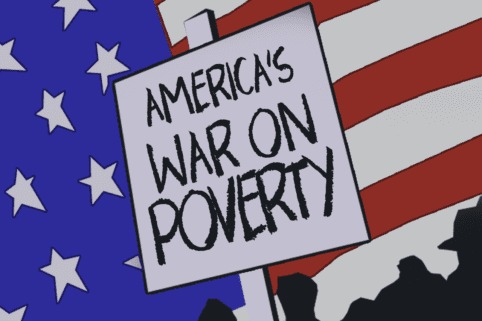How the War on Poverty Will End: The Past and Future of Poverty Alleviation in America
 Nathan Mayo
Nathan Mayo
Vice President of Operations & Programs
Read more from Nathan
Listen to this article:
Despite massive monetary and programmatic efforts over the past five decades, poverty as defined by the US government has stubbornly persisted since the initiation of the War on Poverty in the mid-1960’s. Indeed, though federal and state governments spend 1.8 trillion dollars a year on aid to the poor, the poverty rate has barely moved.
Critics of that assessment point out standards of living among the poor have risen. That’s true– if you take into account welfare benefits–which the official measure excludes. Still, it’s clear the percentage of people unable to provide for themselves is similar to that of the 1970’s (12.6% in 1970, 11.5% in 2022). Further, though some evidence suggests material living standards have improved, most indicators of the poor’s physical, relational, and spiritual health show their situation has worsened.
For instance:
- 65% of working age people in poverty did not work for a single week in 2022.
- Male labor force participation is at a record low.
- Disability claims have significantly outpaced population growth.
- So called “deaths of despair” from suicide and drug overdoses are at record highs.
- Two-parent families have declined, especially among the poor.
- Church attendance among the poor is at a record low.
It’s worth observing that the poor aren’t a completely static class; many individuals are only poor for a period of their lives. However, for many born into poverty, isolation, dysfunction, and generational poverty is the norm. All of that despite major advances in our economic and technological growth. It’s worth stopping to consider just how dramatically we’ve faltered–and why.
Anatomy of a failure
While there’s never been a “golden age” for poverty, most economic, social, and educational indicators trended positive for lower-income Americans prior to the beginning of the War on Poverty–regardless of race. It’s instructive to note that prior to its inception, civil society (i.e. churches, charities, mutual aid societies, and extended families) took the lead role in assisting the down and out.
Unfortunately, well-meaning bureaucrats came to believe government-sponsored transactional aid is a better alternative than civil society’s relational aid. They rapidly implemented that strategy, resulting in the government now standing at center stage. Tragically, at the precise moment civil society should have insisted its role not be minimized, it adapted its form of assistance to mimic public relief. Meeting immediate needs became the focus, without much attention paid to breaking cycles of poverty or building meaningful relationships to overcome alienation. (A contributing factor to that shift was also the church voluntarily stepping back its efforts due to concerns over the social gospel movement).
Time has shown how inept that approach is; government-inspired transfer payments have not solved the problem of economic mobility or communal alienation. Instead, that approach is a primary reason there has been no substantial reduction in intergenerational poverty.
Despite the convictions of some, lack of economic opportunity hasn’t been the driving factor, as seen in part by the success of immigrants arriving from poor countries (many of whom are racial minorities). Nor is racism the major culprit, as evidenced by isolation, dysfunction, and generational poverty in the inner-city and Appalachia. Neither does the breakdown of the family, addiction, loss of community, changes in American schools, the loosening of sexual mores, and the reduction in religious observance bear sole responsibility. While these factors doubtless contribute to the negative trends, they are also present in the middle and upper classes–yet their negative trends have been far less pronounced than those of the poor.
The transition from civil society to transfer payments has made the American poor far less resilient against these negative cultural forces and less able to take advantage of economic opportunities than previous generations.
Toward a workable solution
There are three basic spheres in which all people interact: the market (i.e. for-profit business), the government, and civil society (mentioned above). Each has strengths that if deployed properly, benefit society. Conversely, each has weaknesses that can harm it.
For instance, the government is well-positioned to use force to provide for the common defense and protect people from fraud, abuse, and other forms of unjust exploitation. The market’s price mechanism and voluntary exchange are good at allocating scarce resources to their most valuable use and innovating new technology. Civil society fosters personal relationships which help people grow, flourish, and get back up when they fall.
To put it another way, when it comes to serving people in poverty, the government is best suited to protect the poor from abuse and exclusion from opportunity. The market is best suited to offer a long-term path out of poverty (work), and civil society (families, churches, charities, and communities) is best equipped to befriend them, encourage them, and get them on the path to personal, social, spiritual, and economic sustainability.
Thus, there was little reason to believe government agencies, renowned for their ability to expand perpetually with diminished outcomes, could offer a good alternative to private charity. As has been seen, that hypothesis has been debunked conclusively.
Even if SNAP, TANF, and numerous other federal programs started reducing poverty tomorrow, current levels of spending (which include poverty alleviation and numerous middle and upper-class entitlements) are unsustainable. In as little as 20 years, the entire system will be bankrupt. Common wisdom opines, “if something cannot go on forever, it will stop.” That means the most likely outcome is what many European countries have faced: The institution of “austerity measures,” or significant program cuts across the board. Since the poor in the U.S. vote in lower numbers than the middle class, it’s an easy deduction their benefits will be cut disproportionately.
A unique opportunity is at hand
That outcome should provide civil society a window of time to regain its role as the dominant player in poverty alleviation. The question is: Will churches, ministries, and families be ready to handle the increased responsibilities? Will their programs be transformative and foster financial independence? Or will they shrink from the challenge?
If we seize the opportunity, we must keep this truth in mind: People in poverty should not be viewed as the objects of our charity but as the subjects of their own stories of development. Assistance provided should build on their assets and capabilities, enabling us to subsidize growth, not misery. We should strengthen existing relationships and build new ones to help people flourish rather than just survive.
While the current system does create obstacles to effective charity, there is still some room for effective charity providers to “crowd in” right now. Many people in poverty are so hungry for change and relationships that they will gladly accept developmental challenges offered by a loving ministry–despite lower-barrier alternatives that are available through the government. That will be all the more true as benefits continue to dry up.
If we do our part, the government’s War on Poverty will go down in history as an unfortunate intermission in an otherwise successful campaign for opportunity and human flourishing, driven by the churches, charities, associations, and families that have always been foundational to its success

This article is just the tip of the iceberg for the practical resources available through the True Charity Network. Check out all of the ways the network can help you learn, connect, and influence here.
Already a member? Access your resources in the member portal.




